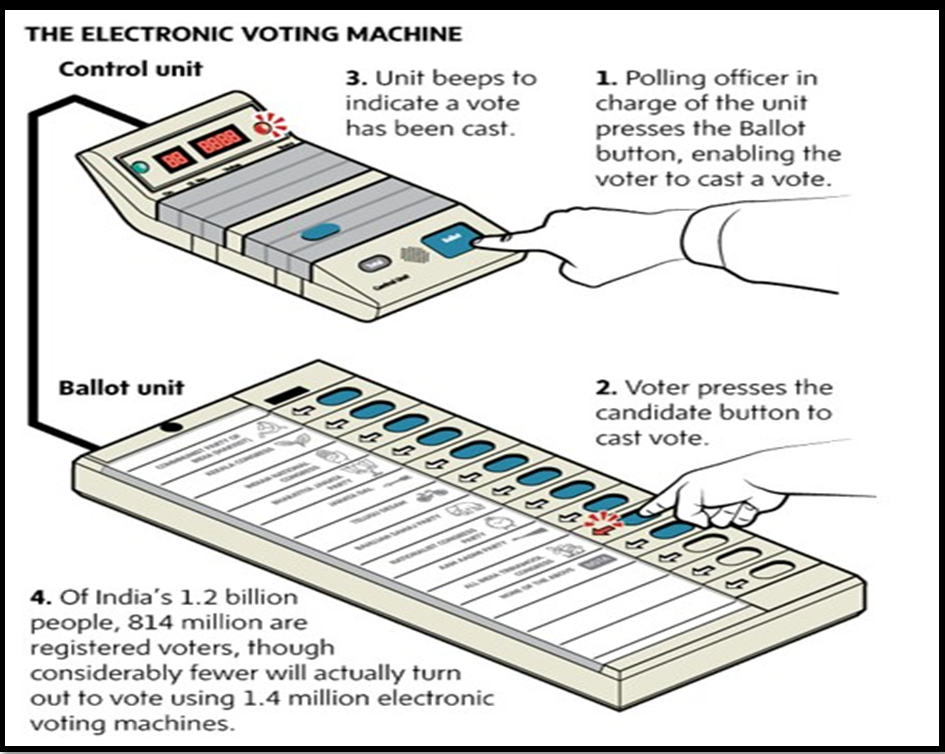ENSURING VOTER ANONYMITY: THE TOTALISER PROPOSAL
Syllabus:
GS 2:
- Transparency and Accountability
- Elections
Focus:
The debate over implementing totalisers in Indian elections has reignited due to concerns over voter anonymity and electoral transparency. Advocates stress its role in preventing voter intimidation, while challenges include technological integration and political opposition.
Source: UGI
Representative’s Controversy
- Recent Incident: Devesh Chandra Thakur, Janata Dal (United) candidate from Sitamarhi, sparked controversy by implying selective assistance based on electoral support.
- Democratic Principles: Criticized for undermining democratic principles by categorizing voters based on community support.
- Opposition Response: Rashtriya Janata Dal (RJD) emphasized the duty of elected leaders to serve all constituents impartially.
| Understanding Totaliser Machine
A totaliser machine, in the context of Electronic Voting Machines (EVMs), is a device used during the counting of votes in elections. Its primary purpose is to aggregate and display the total number of votes received by each candidate across all polling stations within a constituency, instead of revealing results booth-wise. Here’s how it works:
|
Electoral Commission’s Proposal
- Foundational Principle: Voter anonymity crucial to prevent coercion and inducement during elections.
- Historical Context: Introduction of Electronic Voting Machines (EVMs) led to challenges in maintaining voter anonymity.
- Proposal Overview: Totaliser proposed as a solution in 2007 to mask voting patterns and prevent post-election harassment.
- Trial and Reception: Demonstrated in 2008 with political parties’ approval; trialed in 2009 in select elections.
- Government Involvement: Government’s hesitant response and judiciary involvement since 2011 to implement totaliser.
Legal and Political Journey
- Court Directive: Madras High Court’s 2011 order directed the government to consider amending rules for totaliser use.
- Supreme Court Involvement: Yogesh Gupta v. EC case (2014) highlighted concerns over privacy and intimidation, supporting totaliser use.
- Law Commission Support: Law Commission endorsed totaliser in its 255th Report as beneficial for voter protection.
- Political Party Positions: Mixed support among political parties; BSP, Congress, and NCP in favor, CPI(M) cautious, BJP opposed.
- Government Stance: Government cited public interest against totaliser; EC persisted in advocating its necessity.
Current Status and Future Prospects
- Ongoing Debate: The issue of implementing totalisers for vote counting continues to be a subject of debate and legal scrutiny. Recent legal challenges, including the 2017 case (Ashwini Kumar Upadhyay v. Union of India), highlight ongoing concerns and deliberations.
- Supreme Court Involvement: The Supreme Court’s involvement remains crucial in resolving the legal complexities surrounding the use of totalisers in elections. The court’s directives and interpretations will shape future decisions on electoral reforms and voter privacy protections.
- Technological Impact: The debate extends to whether technological advancements, such as the use of totalisers, can effectively mitigate biases and safeguard electoral integrity in a diverse and politically dynamic society like India.
Challenges
- Legal and Regulatory Hurdles: Overcoming bureaucratic delays and legal challenges in amending election rules and gaining consensus among political parties.
- Technological Integration: Ensuring seamless integration of totalisers with existing election infrastructure without disruptions.
- Resource Allocation: Securing funding for procurement, deployment, and maintenance across diverse electoral constituencies.
- Political Opposition: Addressing skepticism and concerns from parties regarding electoral transparency and operational feasibility.
- Public Perception: Managing apprehensions about data privacy, security, and reliability of totalisers.
- Operational Logistics: Training election officials, managing technical support, and ensuring smooth operations during elections.
- Data Security Risks: Mitigating risks associated with data breaches and manipulation through stringent cybersecurity measures.
- Regulatory Compliance: Adhering to regulatory frameworks and international standards while implementing totalisers.
Way Forward
- Legislative Amendments: Advocate for changes in election rules to formalize the use of totalisers, ensuring legal clarity and mandate for their deployment.
- Public Awareness Campaigns: Conduct extensive campaigns to educate voters, political stakeholders, and civil society about totalisers’ benefits in safeguarding voter anonymity and enhancing transparency.
- Stakeholder Consultation: Engage in inclusive dialogue with political parties, election officials, and technical experts to gather feedback and build consensus on totaliser implementation.
- Pilot Projects: Initiate trials in selected constituencies to demonstrate totalisers’ operational feasibility and effectiveness in protecting voter privacy.
- Technical Evaluation: Conduct thorough assessments to ensure the reliability, accuracy, and security of totaliser systems, addressing potential vulnerabilities.
- Capacity Building: Invest in training programs for election officials and stakeholders involved in totaliser deployment, enhancing their proficiency and confidence.
- Legal Safeguards: Implement robust protocols to protect totaliser integrity, including data security measures and prevention of tampering.
- Monitoring and Evaluation: Establish mechanisms for ongoing assessment and refinement based on feedback from elections and stakeholders.
Conclusion:
Implementing totalisers demands navigating legal, technical, and political landscapes. While challenges exist, their deployment promises enhanced electoral integrity. It necessitates robust stakeholder engagement, legal amendments, and meticulous planning to uphold democratic values in India’s electoral processes.
Source:Indian Express
Mains Practice Question:
Discuss the significance of implementing totalisers in Indian elections. What are the challenges associated with their deployment, and how can these be addressed to ensure electoral transparency and voter anonymity?
Associated Articles:




